-
Posts
5,391 -
Joined
-
Last visited
-
Days Won
3
Content Type
Profiles
Forums
Blogs
Gallery
Events
Store
Posts posted by Gordon Williamson
-
-
That center charactor does not look like an "F"
It looks more like "64.." to me. That last character is anyone's guess.
Yeah, I did think it could have looked like 643. The problem is though, if it is a three digit number, whats the other numeral above for. It doesn't make sense. Feldgendarmerie didn't wear unit numbers on their straps. Guess this one will have to remain a mystery.
That strap you posted... is it Heer or LW? It looks LW blue to me.
Its an early Army strap with the Luftwaffe style tresse. It does look a bid odd on this scan, but definitely Army. The colour of the board is the usual dark green.
0 -
Her's an interesting one for Paul. This was in a Kriegsmarine photo album I picked up. Obviously a friend of the naval guy.
Note the blank collar tabs and the shoulder straps with the Heeresverwaltung HV cypher.
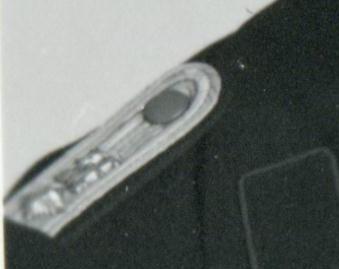
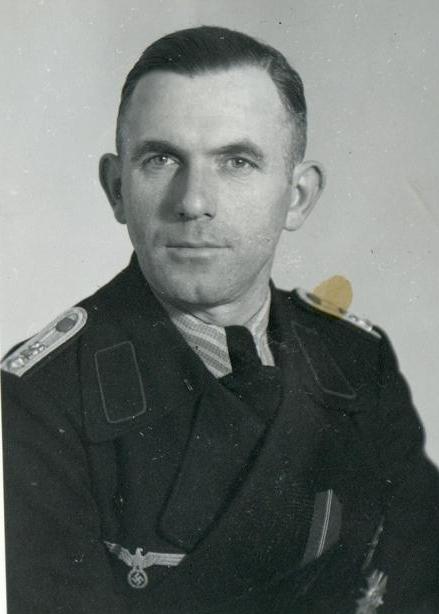 0
0 -
Mike,
Yes, I think they are almost certainly good originals. The Diver patch is the best, and most desirable of them. The low value of the others has meant that there hasn't been any great effort to copy them. Fairly safe badges to have.
0 -
Hi Mike,
Your patches are, left to right
Specialist Patch for Ship's Diver, the red on white is for the summer uniform
Specialist Patch for Gunner/Observer on Light Flak , red on blue for winter uniform
Both the above were worn below any rank chevrons/insignia
Trade Insignia for the Naval Artillery Branch, for summer uniform, worn above the rank chevrons
0 -
Makes sense Rick, as it is known that in the earliest days of the Fg, those who had transferred from the Gendarmerie continued to wear their Police uniforms, either in their entirity with just the yellow on green Feld=Gendarmerie armband (as opposed to cuffband) or re-badged with army insignia.
What got me was that this photo is, at its earliest, May 1942, yet he appears to be wearing a modified Police tunic as a dress uniform. Guess this guy saw himself as a policeman first and formost, and an Army MP second.
Well spotted on the Police Sword too - I hadn't noticed that !
Just proves once again that there are still treasures to be found on good old EBay !
0 -
First ribbon is a KVK2 with Swords device. Pretty sure second one is an Ostmedaille.
Almost certainly an old uniform pulled out of storage for the special day. Problem is identifying which uniform. :blush:
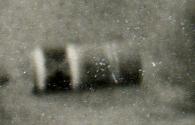 0
0 -
Picked up this very interesdting shot of a Feldgendarmerie Oberfeldwebel on his wedding day.
My fist thought at seeing a small copy of the image before getting the photo in hand was that it was a modified Waffenrock (Note the dark cuffs) to which pockets had been added. Waffenrock modifications were common enough, but had never seen one with dark cuffs left intact.
Then I noticed that the horizontal seam in line with the bottom button as found on the Waffenrock, is missing, yet there are vertical seams under the breast pockets.
I don't imagine that a left over Reichswehr Rock would have had dark green cuffs, so don't think it is that.
Then it occured to me, that this SNCO probably started life as a member of the Motorisierte Gendarmerie (transferred to the army to form the first Feldgendarmerie units). Could this be a modified Police tunic, with the brown cuff and collar facings covered in dark green ?. (I know of visor caps from the Gendarmerie having their brown cap bands covered in green cloth and army badges added for subsequent use after transfer into the Feldgendarmerie so the concept fits)
It is also interestring that although this photo dates for after May 1942 ( he wears the ribbon for the East Front Medal), his cuffband is not the regular BeVo woven type, but a hand embroidered one on brown cloth, same as the Police style "Motorisierte Gendarmerie" cuffband and I believe to be the first type of Feldgendarmerie band made.
 0
0 -
Nothing small about your contribution Martin. Without you, Skip, Jan Arne, Kay, John and all the others, it just wouldn't have happened.
This is always the frustrating part, between handing in the material - and seeing the page proofs materialise. Hopefully it won't be long now.
0 -
Hi Steve,
The book is with the publisher right now (Bender Publications) going through the design and layout stages. Don't know the page count yet but there are around 1000 or so photos covering the badges, miniatures,award documents, photos of the badges in wear etc, etc.
Although the U-Boat Badges are included they are only covered briefly as they were covered in more depth in my book "Torpedo Los!" (also from Bender), so this one concentrates mainly on the badges of the surface units, with close ups of pins, hinges, maker marks etc,
I'll post some sample pages once I have had a chance to see the draft layouts etc.
0 -
I am fortunate enough to own an authentic "field converted" EK2 to RK, with provenance, which belonged to one of Germany's top U-Boat Aces. The "conversion" is as crudely done as the example shown here, (which might well be a genuine period alteration) by twisting the eye around by 90 degrees .
Of course with these, provenance is everything, but there is nothing fake about the one in this thread - its a genuine EK2 and possibly a genuine period alteration, so could well have been worth buying depending on the price being asked and if any background to it was known.
0 -
Close up of the strap doesn't help too much, but the first part of the Cypher could match an upper case "G". The rest isn't clear though. The first could also be a "6", but then if it is a three digit number,rather than letters, why yet another number above it, clearly a "1"
GFP were organised by Gruppe so "1" "GFP" would make sense for an attached person.
If the main part is "GFP" it all makes sense, but if not, then what the heck is it. Any ideas ?
 0
0 -
Feldgendarmerie did not wear cyphers or numbers on their straps (with obvious exceptions such as the GD worn by Grossdeutschland MPs etc)
Orange piped straps with numbers(Roman numerals) are for Wehrkreis Recruitment personnel.
One example of cyphers known to be worn by Feldgendarmerie is the GFP when on temporary attachment to Geheime Feldpolizei units, like this.
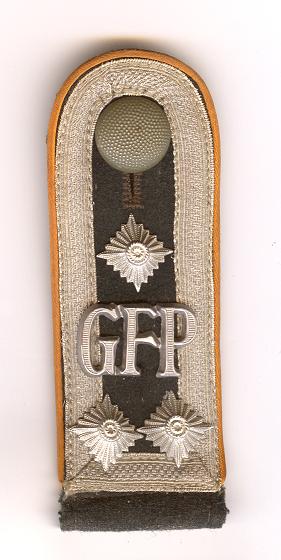 0
0 -
Picked this up primarily as it showed a dog handler and I don't have too many of these. Nice photo but then the cyphers worn by the Stabsfeld on his shoulder straps caught my eye.
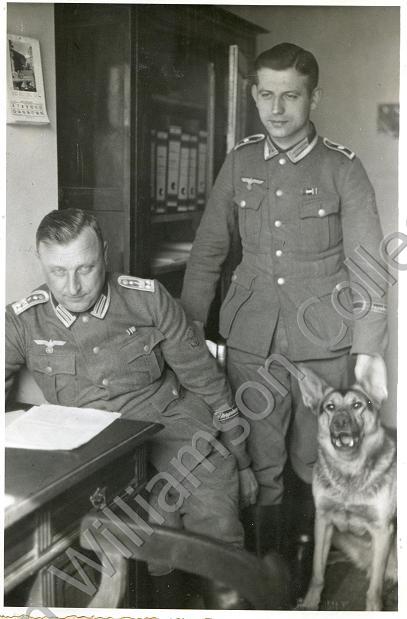 0
0 -
I would not say that Assmann Minesweeperes are rare. Moderately scarce, but not rare. It is hard to find one with all its finish intact though.
0 -
Thanks for the kind comments guys. No major components in the latest batch of parts to arrive. What you see are the base units with the winches etc for the large aircraft cranes, plus some of the flak guns. Nice that they have correctly reflected that there were two distinct types of heavy flak mount.
Second shot with the coin is just to show the size of these little 3.7cm flak guns in 1/200 scale. A lot easier than working in 1/350 or 1/700 but still pretty tiny.
131 issues now in, from a total of 140. Next batch should be the stage where the wooden decks are attached and it should all start to come together quickly after that. At this stage many of the sub-assemblies still have a few parts that are still to come so can't be finished off yet. Aim to have it finished before Christmas.
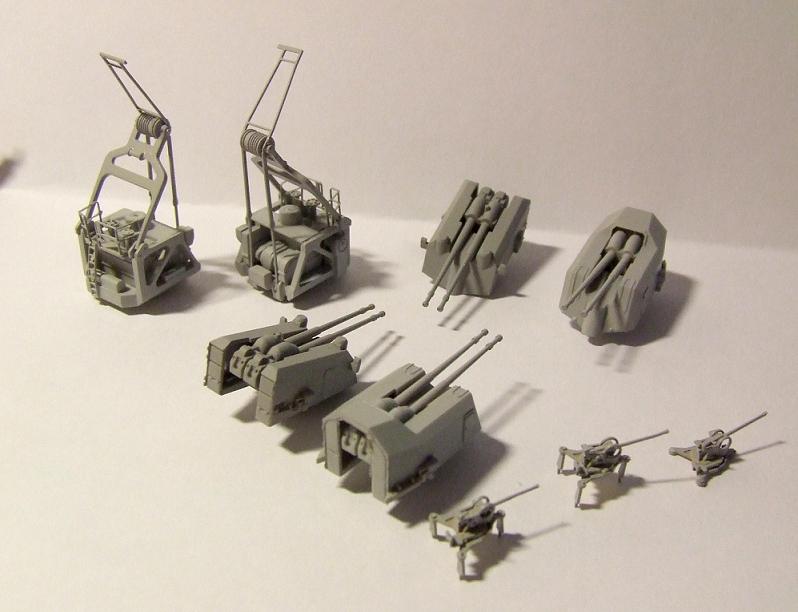
 0
0 -
Superb. Unique and dramatic way to display the model.
0 -
In the photo the guy is wearing the white version of the sailors shirt with the Parade Jacket. By regulation, the blue uniform was worn except for during the summer months but in reality it was quite common for "mixed dress" to be worn. White shirt with blue trousers, blue shirt with white trousers etc. You can even find two guys in the same photo wearing the opposite combinations.
I'll dig out some examples.
0 -
A shirt is essential for displaying the Parade Jacket though. It is very visible, especially with the collar being worn outside the jacket.
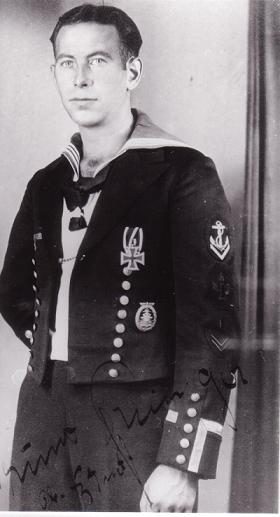 0
0 -
Hi Bob,
Yes you can definitely get away with not using a shirt with the Pea Jacket. As you can see, when worn, with the shirt collar inside, very little of the shirt was visible anyway.
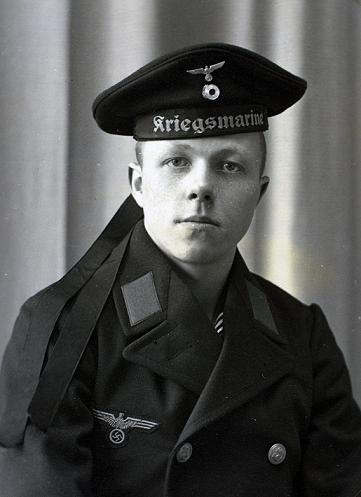 0
0 -
I picked up a Kriegsmarine Schloffelmutze with the cap tally: Marine Nachrichten Schule. I also just picked up a radioman's pea jacket and trousers so that all goes well together.
Anybody know what they wore under their pea jackets, what kind of shirt?
Bob
(Photo by Bill Shea, The Ruptured Duck)
Bob, the Pea Jacket was worn over the regular sailors shirt with "Nelson Collar". Not too hard to find and usually modestly priced, so you should be able to complete the "set" without too much extra cost.
Note that the Collar was worn inside the jacket. With the Parade Jacket, the collar was worn outside the jacket.
0 -
Here is the named armada so far.
Regards,
JustinG
2dresq
Very impressive. As with your badges, you've made great progress over just a short period.
Nice to see the Gneisenau settled in its new home !
0 -
Very nice. You have done well to put this lot together in a relatively short time.
0 -
Yes, definitely Torpedoboote, but not the Raubtier or Raubvogel class which as you rightly say, had call letters rather than numbers. Another clue is in the funnels, the Raubtier/Raubvogel had a wider forward funnel and narrower aft funnel. The fact the both funnels are around the same size suggests these are left over WW1 Torpedoboats, possibly T16Mob class. The bulk of these were scrapped or otherwise disposed of after the war but I have seen reference to four modified examples of this type being commissioned between 1919 and 1921 and which presumably served in the Reichsmarine and the early days of the Kriegsmarine.
0 -
Chris and Gordon have summarised my points quite well. I tend to agree with Gordon regarding LDO-marked awards. I think an LDO-marked Zimmermann/Godet RK should sell for about €1,000.00 while the PKA-marked version sells for €10,000.00. This should make Uwe Speedytop happy. Copies are copies are copies. Of course, we're in trouble with an Assmann L/64 "A" Fallschirmschützenabzeichen because it bears two type of maker's mark. But if it bears an LDO mark, it is just a copy.
Prosper brings in two additional factors.
First - rarity. Of course the LDO marked version of the Zimmermann cross is far rarer than the official Präidialkanzlei marked "20" version. So it is no surprise that there will be collectors who will pay a premium price for one, Its a matter of personal taste. I own a "20" marked example and I would never trade it for an LDO marked example which to me, rarity notwithstanding, is a retail Copy.
I own an L/15 marked Destroyer Badge by Otto Schickle. Schickle went out of business very shortly after the LDO marks were introduced and I know of no other L/15 Destroyer badge around ( I sure there are some, but they are in a different league of rarity compared with, say, the popular Schwerin pieces) but I only bought it to get good images for a book and will trade it immediately I see an official award piece I like.
Others might no doubt keep and treasure it. Different tastes.
Second - Double marked pieces. No way of knowing of course whether many of these (eg the double marked Zimmermann or Steinhauer EK1s) started as official marked pieces then had an LDO stamp added to legitimise it for retail sale, or vice versa. These to me are in a grey area as to their original intended use, but there are of course collectors who add even more value to something like that which is double marked. Different tastes.
Chris made valid points about the second piece bought by a soldier and worn in combat. Of course to some this has extra appeal. But consider this, - the soldier probably kept his award piece safe at home because he valued it more as the official award piece than some retail piece he bought over the counter in a shop, and wasn't worried about it getting damaged.
I fully agree with Chris about terminology. It seems like every day some new "definition" is created by a cabal of collectors on some forums and almost immediately taken into general used as established "official" terminology. Best ignored. Try telling a veteran that his a "Type 1 (a) (ii) second pattern X badge by Steinhauer with a first model Juncker type pin made at the Schwerin factory" (no doubt on a Friday - by Hans- who had Liverwurst for breakfast)" and he will almost certainly look at you like you are some sort of retard. He'll probably be right.
Prosper of course made a really important point here. To the vast majority of German vets, the badge hasn't all that much worth - its the Award Document that counts. His badge is probably identical to thousands of others, but his award document is unique - it is to HIM and him alone.
0




U-boote identification question
in Germany: Third Reich: Uniforms, Headwear, Insignia & Equipment
Posted
Hi Norm,
These are Type II boats. More specifically, they look like Type IIc in which the front face of the tower was flush ( the Type IIa and Type IIb had a stepped front). Hard to be certain as the lower part of the tower on the TYpe IIa and TYpe IIb was only slightly more prominent than the upper half. Only 8 of the Type IIc were built. Limited range and payload, so only for use in coastal waters.
Attached some drawings to show the flush /stepped tower.
Heres a scale model of a Type II so you can see her from various angles.
http://gmic.co.uk/index.php?showtopic=29451